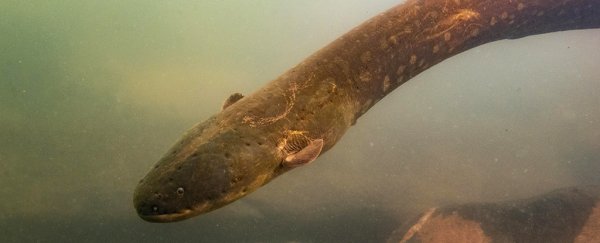Prepare yourself for a shock of the record-breaking variety – scientists have identified two new electric eel species, and one of them can put out a zap that's stronger than any other animal we know about.
The supercharged species is Electrophorus voltai, and it can discharge 860 V of electricity in a single shock, some way ahead of the 650 V shock that electric eels are normally associated with. It's definitely enough to cause a human-sized creature some serious pain, and is several times more shocking than a taser gun.
As for the other new species identified by the latest research, it's called E. varii. Though it can 'only' muster a maximum of 572 V with its shocks, these two animals open up a whole new way of thinking about the electric eel.
 E. varii. (D. Bastos)
E. varii. (D. Bastos)
It was previously believed that there was just one species of electric eel, E. electricus, first discovered more than 250 years ago. These new findings from the Amazon basin emphasise the diversity of life within it – much of it still left for us to discover – and the importance of preserving that life.
"Here, based on overwhelming patterns of genetic, morphological, and ecological data, we reject the hypothesis of a single species broadly distributed throughout Greater Amazonia," write the researchers in their published paper.
"Our analyses readily identify three major lineages that diverged during the Miocene and Pliocene – two of which warrant recognition as new species. For one of the new species, we recorded a discharge of 860 V, well above 650 V previously cited for Electrophorus, making it the strongest living bioelectricity generator."
To identify E. voltai and E. varii, the researchers carried out some detailed DNA analysis on 107 eel samples, finding that they diverged from E. electricus around 7.1 million and 3.6 million years ago. Each species has its own distinct regional area, too.
That might be one of the reasons that E. voltai has developed such a shock, the researchers suggest: to adapt to life in highland waters, which don't conduct electricity quite so well.
In terms of physical differences, the researchers noted small differences in skull shape, the pectoral fins, and the arrangement of pores on the body between the three species.
Electric eels, which are actually fish rather than eels, use their specialised nervous systems to produce voltage, deploying it to sense their surroundings and to neutralise prey.
The electric eel actually inspired the invention of the first battery back in 1799, and these new findings might help us to understand more about how these fish generate high-voltage electricity.
"[E. voltai] could really have different enzymes, different compounds that could be used in medicine or could inspire new technology," says zoologist C David de Santana, from the Smithsonian National Museum of Natural History in Washington DC.
And if scientists are to make dramatic findings like this in the future, it's important that one of the most biodiverse natural areas on the planet – the Amazon basin – is protected against the damaging effects of human activity.
"In spite of all human impact on the Amazon rainforest in the last 50 years, we can still discover giant fishes like the two new species of electric eels," de Santana told The Guardian.
The research has been published in Nature Communications.
